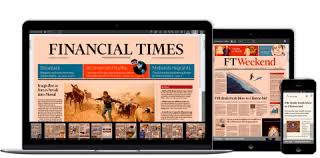The Financial Times is one of the world’s leading news organizations. It is globally recognized for its authority, integrity, and accuracy. It is part of Nikkei Inc., which provides a broad range of information, news, and services for global business. This article will help you understand more about the Financial Times newspaper, its history, subscription, and free tips. So, stop searching further and relax because all you need to know about the Financial Times is explained in this article. Isn’t that exciting? Let’s advance further together.
Financial Times News
Financial Times News is a print and edit in London, that has a strong influence on the financial policies of the British government locally. The paper version is printed daily, except Sundays, throughout the world. It is also one of England’s superior newspapers.
The paper has two sections. The first section covers domestic and international news. It also covers the editorial commentary on politics and economics from FT journalists such as Martin Wolf, Gillian Tett, and Edward Luce. This also consists of opinion pieces from globally renowned leaders, policymakers, academics, and commentators. The second section deals with financial data and news about companies and markets. However, it does also contain TV listings, weather, and more informal articles.
What Type of Newspaper Is the Financial Times?
The weekday Financial Times newspaper is one of the world’s biggest sources of news and information on business, politics, and international affairs.
Read Also: Top 7 Time Management Strategies That Make or Mar Your Business.
Financial Times History
According to history, the Financial Times was first launched as the London Financial Guide on January 10, 1888. Later renamed to Financial Times on 13 February the same year. The history of the Financial Times still states that James Sheridan and his brother are the co-founders. It has competed for many years with four other finance-oriented papers. Finally, absorbing the last of these, the Financial News (founded in 1884). Basically, after 57 years of rivalry, Brendan merged the Financial Times and Financial News in 1945. This merger resulted in the formation of a single six-page newspaper.
The company Pearson bought a controlling stake in the Financial Times in 1957. History says that the newspaper’s circulation expanded significantly during the second half of the 20th century, and the paper’s scope became global. Its printing expanded to several cities in Europe, Asia, and North America, and various international versions launched as at that time. By the late 1990s, the newspaper circulated outside the United Kingdom exceeded that within. The Web site of the Financial Times debuted in 1995, with for-pay features and subscriptions introduced in 2002. In 1994 the newspaper also began publishing the lifestyle magazine How to Spend It.
The Japanese media company Nikkei purchased the FT Group, the holdings of which included the newspaper, on July 23, 2015, for £844 million, which is equivalent to $1.32 billion. The acquisition was completed on 30 November of the same year.
The Financial Times history specialized in reporting business and financial news and has maintained an independent editorial outlook. They have taken the lead in financial news and updates globally. In the second decade of the 21st century, the Financial Times had a daily readership of more than two million people. The readership includes the paper and electronic versions of the Financial Times. Since the 1890s, the newspaper has been identifiable by its unique pink paper, design element echoed across its digital products.
You may also read: The Coca-Cola History and Its Success Facts.
Financial Times Newspaper
Looking for an international daily newspaper to read daily? Then consider the Financial Times newspaper, printed in broadsheet and published digitally. Meanwhile, it focuses mainly on business and economic current affairs. The history of the Financial Times newspaper is based in London, England. The Nikkei company owned the paper but has core editorial offices across Britain, the United States, and continental Europe. In Spring 2019, it reported one million paying subscriptions, three-quarters of which are digital subscriptions. The newspaper has a prominent focus on financial journalism and economic analysis over generalist reporting. It draws both criticism and acclaim. The daily sponsors an annual book award and publishes a “Person of the year” feature.
However, from the late 19th to mid-20th century, the editorial expansion for the FT was facilitated globally. In the same period, the paper added opinion columns, political cartoons, reader letters, and special reports. Moreover, the paper still contains book reviews, technology articles, and political features global. You can recognize the FT newspaper by its unique light-pink broadsheet and digital display. It’s also supplemented by its lifestyle magazine, the weekend edition, and a small portfolio of industry publications.
Read also: List of Most Profitable Small Businesses: top 35 + detailed guide.
Financial Times UK
The Financial Times newspaper, though owned by the Japanese holding company Nikkei has its base in London, England. As history shows, the paper locally had a strong influence on the financial policies of the British government throughout history talks. FT has its headquarters in Bracken House at 10 Cannon Street, near the city’s financial center. At Bracken House is where FT maintains its publishing house, corporate center, and main editorial office. The city of London is the financial community of the readership of the Financial Times newspaper. In 2002, FT introduced subscription services to its website and digital. Therefore, making it one of the few UK news sites successfully funded by individual subscriptions.
How Much Do Ft Journalists Earn?
The annual salary for a journalist at the Financial Times is typically around £50,275. At the Financial Times, annual wages for journalists can range anywhere from £45,062 to £84,994 per year.
Is Financial Times a Good Company to Work For?
According to ratings and comments posted on Glassdoor by current and former employees of the Financial Times, 81 % would recommend working there to a friend.
Financial Times Subscription
The Financial Times Subscription keeps you abreast of significant corporate, financial, and political developments around the world. It also keeps you informed and helps you spot emerging risks and opportunities with independent global reporting. FT contains expert commentary and analysis you can always trust. It’s widely and globally accepted to be true and accurate. Thereby, the subscription is worth the pay.
Financial Times subscriptions come in five ways, and each has its own package rate and benefits. These subscription packages include:
#1. Trial
The Financial Times Trial subscription offers new readers a 4-week trial subscription. This gives new readers full access to FT.com for only $1, £1, or €1, or 10 Hong Kong dollars. The FT digital trial gives you a taste of its Premium Digital subscription so you can make your best decision. The digital trial also offers Print and Print + Digital Trials for readers living or working within its delivery areas.
The trial has a fee of $1.00 and only lasts for 4 weeks. Note that failure to cancel after the 4-week expiration will roll the reader onto a monthly subscription of $67.00.
#2. Digital
Digital is the Financial Times subscription essential package that gives you access to the wide breadth of award-winning FT journalism. It will also grant you access to all of its essential news coverage, which includes graphics, podcasts, and videos. Digital comes with a subscription fee of $39.50 per month, or $369.20 for 1 year. Its benefits include access to the following:
- MyFT – a place you can view articles on your followed topics, save articles, and set up custom email alerts
- The FT app – with breaking news notifications and offline reading
- Life and Art articles
- Markets Data and Portfolio tools
- Subscriber exclusive newsletters, which include FirstFT, Long Story Short, and FT Opinion
- You can share 10 gift articles per month with anyone
A Premium subscription gives you everything a Digital subscription does, but with some added depth and insight. It’s widely considered the ultimate tool for decision-makers. However, it comes with a fee of $67.00 per month. Benefits of a Premium FT subscription include access to the following:
- Merger and Acquisition coverage
- Additional, Premium-only, newsletter including Editor’s Choice, Market Forces, and Trade Secrets
- The ePaper, a digital replica of its printed newspaper
- Lex, a daily commentary service to help you make better investment decisions
- You can share 20 gift articles a month with anyone.
#4. Financial Times Magazine Print
The Financial Times magazine print subscription grants access to the FT print edition delivered Monday through Saturday along with e-paper access. This subscription is not always available in every country. Countries in which this subscription is unavailable can consider the digital replica of the print edition for $99.00 per year. This is easy to navigate and is available on desktop, mobile, and tablet.
#5. Team or Enterprise
An FT Team Subscription provides a cost-effective way to equip teams with trusted FT journalism. The subscription is also a group subscription. It comes with premium FT.com access for multiple users, with integrations & admin tools. The subscription fee is “pay based on use,” and it accommodates 2 to 1000 readers. Nevertheless, with a group subscription, the team can access FT journalism at scale. It also helps them identify opportunities, mitigate risks, and stay ahead of their competitors.
Note, Students can also stand out from the competition with the FT’s exclusive student offer for just $3.55 per week. This offer includes multichannel access to personalized news alerts, specialist blogs, videos, and infographic. Get more free tips on Financial Times below.
Financial Times Free Tips
The Financial Times newspaper covers over 600 journalists reporting from over 40 countries around the globe. However, there is a whole world of insight to be discovered on FT.com. So, the Financial Times’ tips will help you more on the go. With these Financial Times tips, discovering more on FT.com is made easier. Reading through these tips on The Financial Times also saves you more time and energy as both an old and new subscriber.
Below are a few Financial Times tips to get you started on FT.com.
#1: Tick the “remember me” box when signing in to save you time for your next visit to FT.com
#2: Save FT.com as your home page or as a bookmark in your browser so you can get to FT.com quickly and easily
#3: Add topics, people, journalists, regions, and more to your myFT so you can track the stories important to you
#4: Set up instant alerts or daily or weekly email digests on the topics you follow
#5: Download the FT app to your Apple or Android device so you can read the FT while traveling, on the go or even when you’re in the air
#6: Subscribe to one of FT’s curated email newsletters on a range of topics, for insight and unique commentary from our editors straight to your inbox
#7: Take advantage of the article ‘save’ button to bookmark articles and build lists of articles so you can refer back to them or share them with colleagues or students
#8: Read articles from the Opinion section where FT top journalists help you to make sense of the day’s main news stories
#9: Download FT ePaper to read a digital replica of the printed newspaper to see what headlines made front-page news (available to Premium subscribers only).
#10: The Markets Data tool is there to build your charts and see the impact of events on your share prices.
Is Financial Times Free for Students?
Students get free access to FT.com. They can benefit from it by generating new and relevant ideas for use in writing assignments, exams, co-curricular activities, and job interviews.
Conclusion
From the historical stage of FT to date, it has stood a test of time. Providing accurate information from the world of business, politics, entertainment, and a lot more. The beauty of its content has attracted over a million subscribers, who wait to read every single article. Honestly, subscribing to any FT news package is worth it, but this is advisable for people who can afford the subscription.
However, there are many who can’t afford the FT subscriptions, which is why we are here. Here at BusinessYield, we bring the same accurate business and other related information to your doorsteps. This comes on a platter of gold for both our old and new visitors.
How Would You Describe the Financial Times?
The Financial Times is widely considered one of the most reputable news organizations in the world due to its impeccable track record for honesty, fairness, and precision in reporting.
Is Financial Times Still Pink?
Even today, the Financial Times is published in a pink color, which has become a defining characteristic of the publication.
What Kind of People Read the Financial Times?
The Financial Times is a reliable source for business leaders and people with a lot of personal wealth. The readers include some of the most powerful people in business and politics, as well as some of the world’s wealthiest and most discerning consumers.





